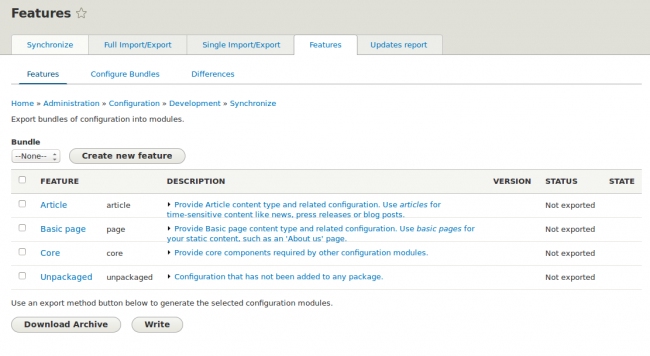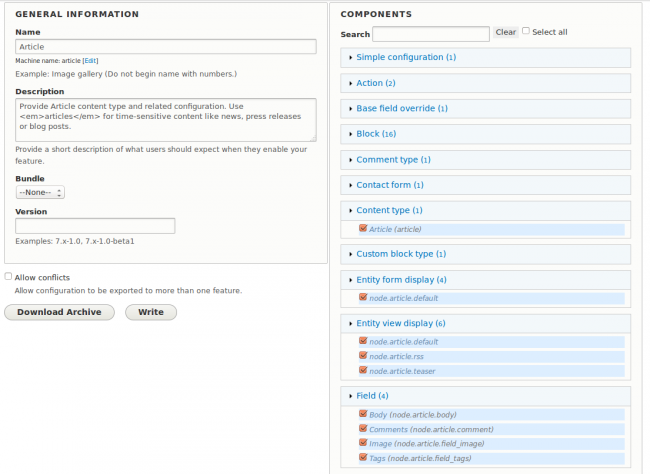Drupal 8 Configuration Management with Features
Drupal 8 Configuration Management with Features
This is a preview of Nuvole's training at DrupalCon Los Angeles: "An Effective Development Workflow in Drupal 8".
Features for Drupal 8 will exist and it is already in alpha state. This may be surprising to those who wrongly assumed that Configuration Management was going to supersede Features; but, as we explained before, it all comes down to understanding how to use Features the right way in Drupal 8.
If you are using Features in Drupal 8 for deployment of configuration, you are doing it wrong!™
The role of Features
While the configuration management was built to keep configuration consistent and enable deploying it between different environments of the same site it was not built for sharing configuration between different sites. This is where Features comes in. Features allows you to easily bundle related configuration and re-use it on another site.
For re-using configuration and building starter profiles the current alpha version is already great. It works just like the re-usable “feature” we were blogging about last year, except it comes with a familiar UI and lets you do everything as a site builder. It even comes with a smart system that auto detects configuration that belongs together.

Configuration changes are development
Developers and site builders working with configuration in Drupal 8 need to understand that changing configuration needs to be treated equally with development. While this may seem trivial at first, the consequences are a fundamental shift to the approach of building a Drupal 8 site.
Drupal 8 comes with the configuration management system that was built to deploy configuration between different environments of the same site. It allows the whole configuration of a site to be synchronized both through the UI for “site builders” and through drush and git for “developers”. While the system allows individual configuration objects to be exported and imported, deployment and synchronization is always done with the entire set to ensure it is consistent.
This means that when you change configuration on a production site you either opt out of using the configuration management to deploy configuration or you need to go through a more elaborate work flow to synchronize the configuration changes with the development environments similar to what you would need to do if you were to change code directly on the production server.
For the math-oriented,
Δ config ⊆ development
What if you want to be free of the temptation to edit configuration in production? Luckily there is a module for that! It is called Configuration read-only mode and allows to lock the forms where you change the configuration, thus enforcing its role as a "developers only" tool.
Of course some configuration will differ between environments. Just as the database credentials are kept separate from the rest of the code, specific configuration can be overridden in the instances’ settings.php or services.yml. The rest of the code is usually treated as a whole for consistency reasons, the same should be true for configuration.
What about not using configuration management?
Features and packaging related modules should not be regarded as a solution to deploy only partial configuration. Packaged configuration by definition is never aware of the whole site and the possible inter-dependencies of the site's particular configuration. Deploying only partial configuration circumvents the safeguards Drupal put in place to make the deployment more robust. Of course nobody is forced to use the new tools for configuration management and you can easily opt out of using it by just ignoring that option. It is also still possible to develop a Drupal 8 site by sharing a database dump just as with Drupal 5. But remember that a Drupal 7 approach will yield the Drupal 7 headaches. We would recommend re-evaluating the deployment strategies when starting to use Drupal 8.
Managing distributions in Drupal 8
The more complicated scenario which is yet to be tackled is a feature for a richer distribution which will update over time. For example a newer version of a feature could come with an updated view or additional or updated fields for a content type.
First steps in that direction have already been taken by Configuration Update Manager (a dependency of features) and Configuration Synchronizer (a sandbox module). Configuration Update Manager compares the configuration in use on the site with the configuration which was provided by a module or installation profile. Configuration Synchronizer goes a step further and keeps a snapshot of the configuration when it was installed in order to determine whether the configuration has been customized by an administrator or whether it can safely be updated to the one provided in the new version of the module/feature.
All the modules mentioned above are used in a development environment of a particular site. Or in other words in an environment where configuration changes are expected and part of the process of updating a site.
For more, see our presentation from the Drupal Developer Days (embedded below); thanks to all the people there for the fruitful discussions we had on this topic during the event.
 | 2015-04-devdays-montpellier.pdf (711.18 KB) | Download |

